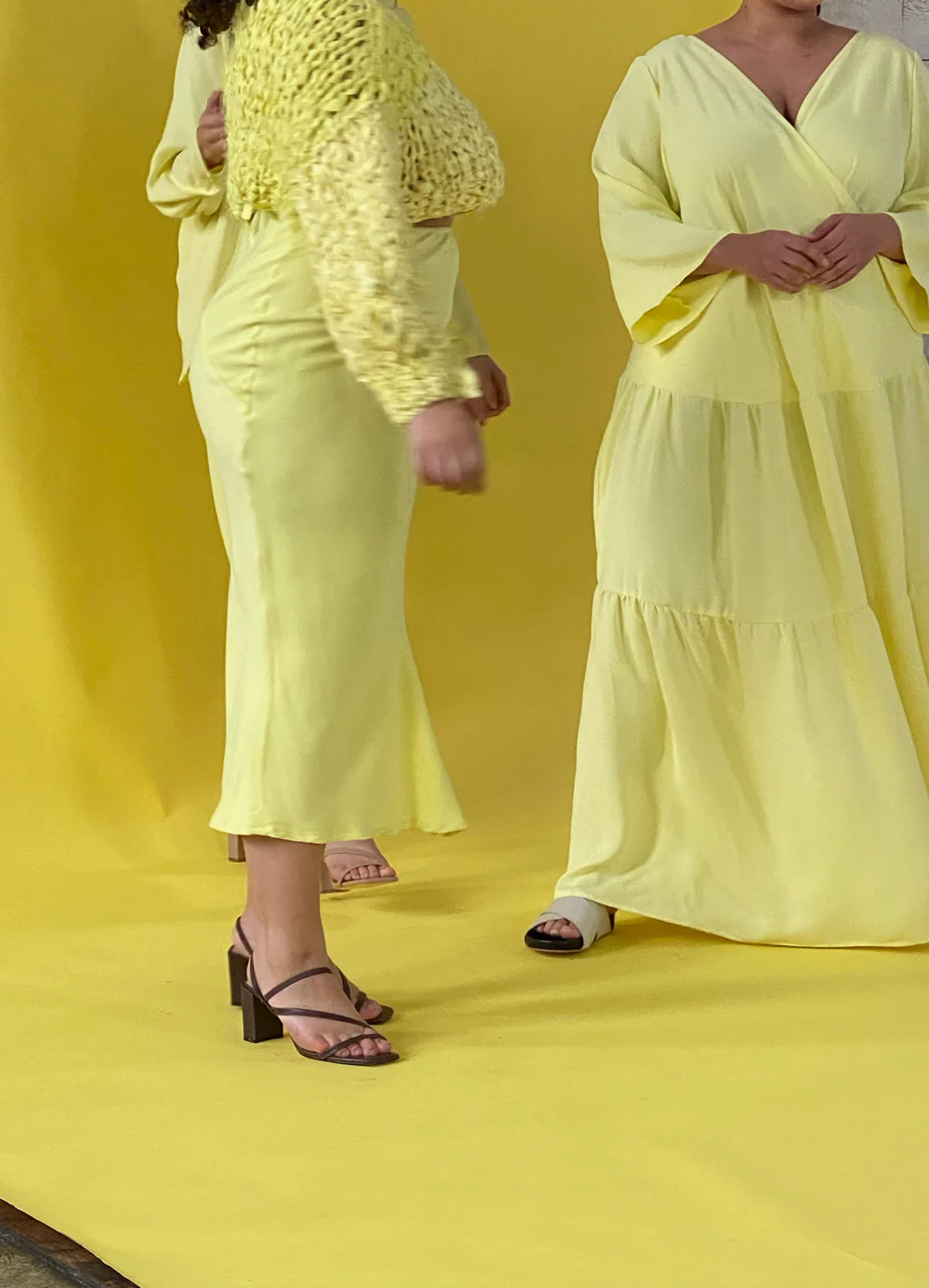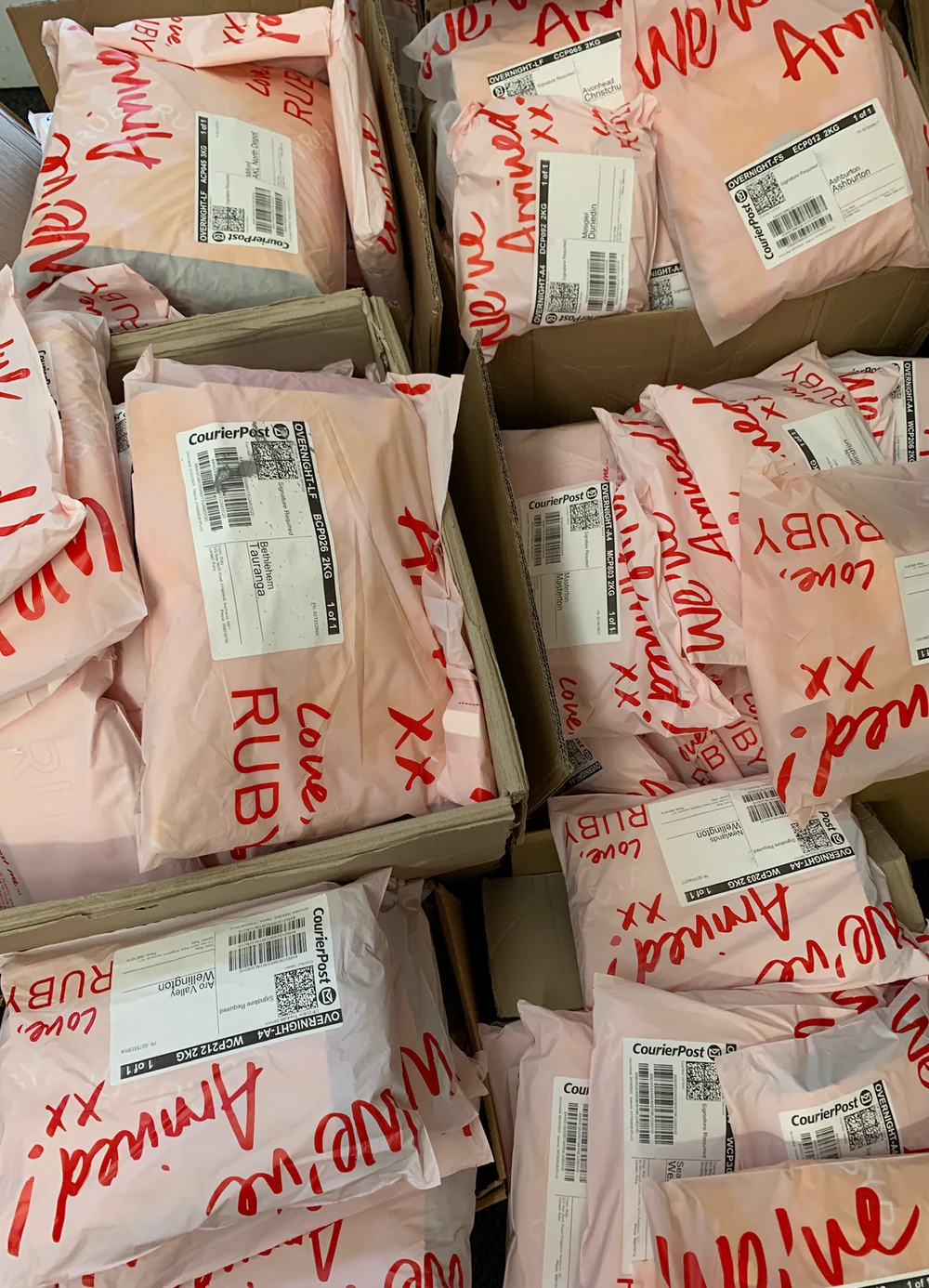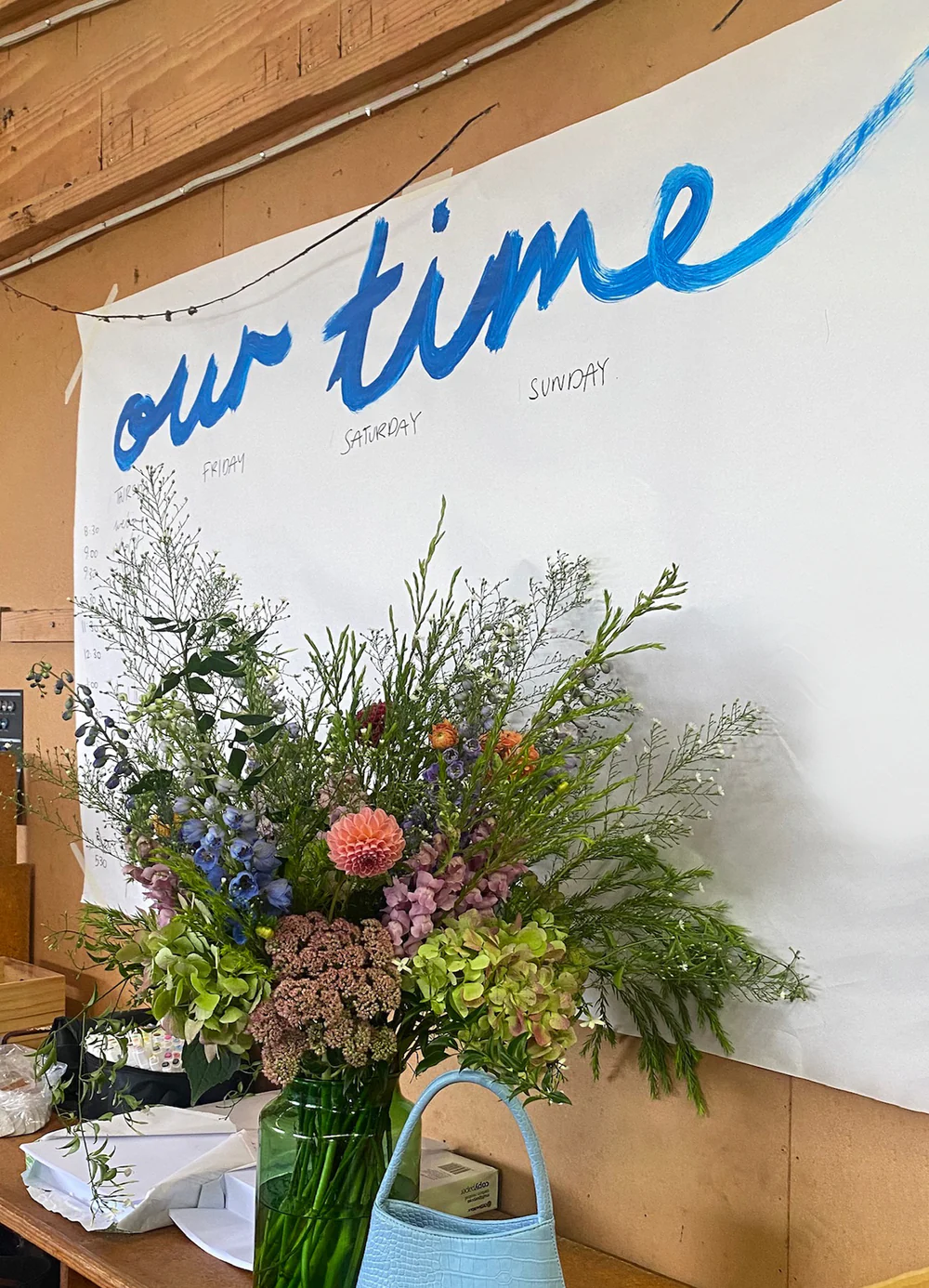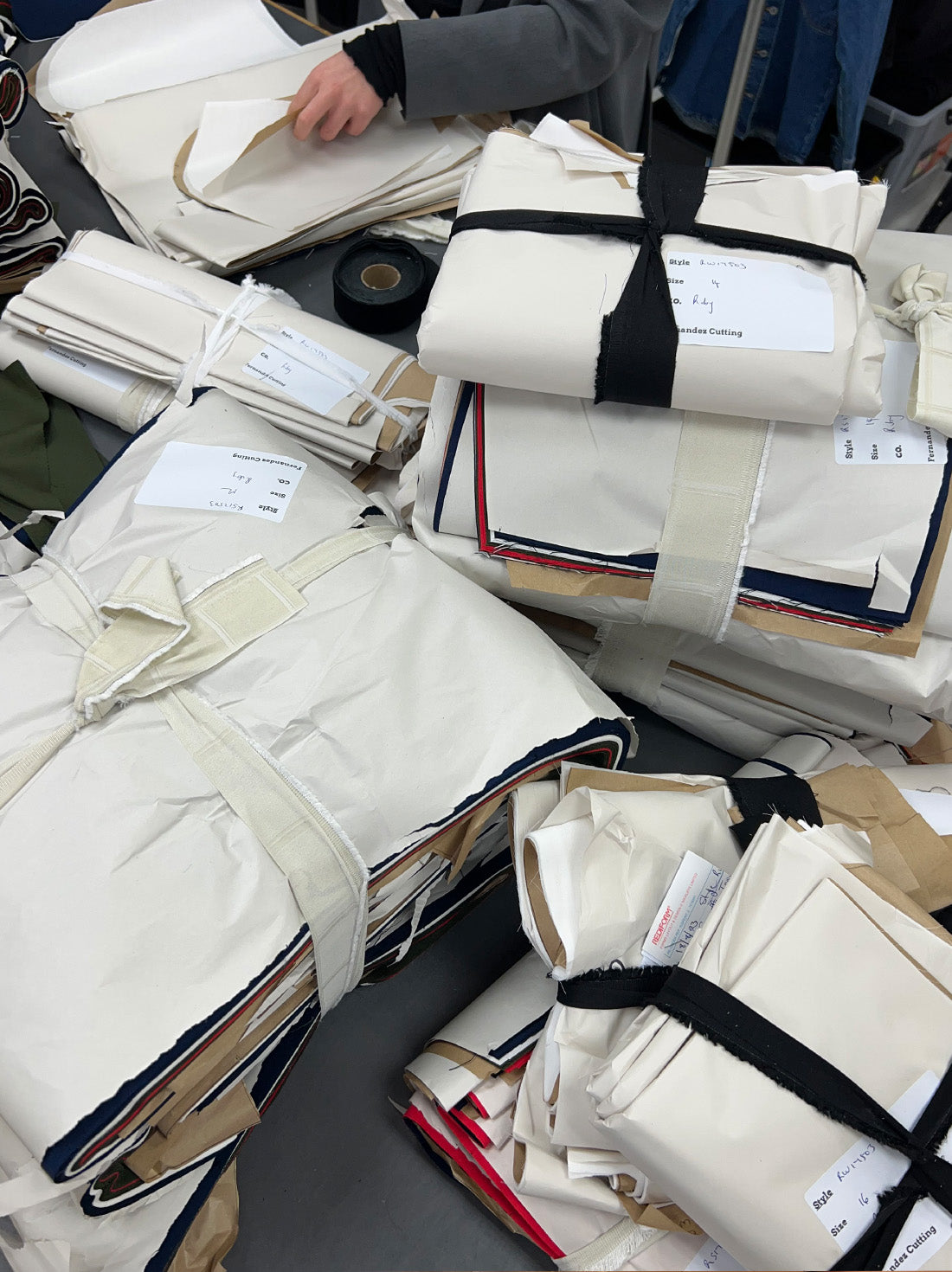Toolbox / Materials
Materials
What we have learned is there is no “sustainable” material, instead there are some choices that are better than others.
Global Life Cycle data collated by World Resources Institute in November 2021 demonstrates that fashion’s biggest emissions (and other environmental impacts) are in the materials phase of the supply chain.
Every material requires the use of resources such as land, energy and water, and has an impact (both positive and negative) on the people that produce them.
The work we do to continuously improve the materials we use is a crucial part of our Toolbox for Change strategy. It is our goal to continue to make verifiably better choices, and to educate you about what we learn along the way.
The fabric production supply chain, a note...
It’s helpful to be clear about the different stages in the fabric production process we talk about in this section. There’s a lot of information in here, so please get in touch if you would like some help understanding it.
- Raw Material Production (Tier 4): The creation or collection of the raw material used to make a fabric. For example on farms, forests, plantations, recycling plants, petroleum extraction and polymerisation.
This stage may also include the processing of the raw material (for example ginning cotton, carding wool, scutching flax or extruding polyester), but may also fall under tier 3 yarn production (for example acetate and viscose, as the raw materials are processed in a factory that differs from the location of the forests where wood pulp comes from).
- Yarn Production (Tier 3): Spinning processed raw material into strands of yarn.
This may also include the processing of the raw material as mentioned above.
- Fabric Production (Tier 2): Weaving or knitting of yarn into fabric.
- Fabric Finishing (also Tier 2): Preparation for dyeing, printing, washing, drying and setting (which usually includes processes such as singeing, sizing, desizing, scouring, bleaching, mercerising).
- Fabric Supplier (Tier 1): The seller and exporter that trades with fabric mills, wholesale markets and buyers. In most cases, we work directly with them.
In the Fabric section of our Materials Index, we list as far back as we have traced or verified for each fabric. Because of the commodity nature of some raw materials (such as cotton or polyester) and the lack of technology, we are often only able to identify the region or country the raw material has come from, we can't always trace back to the precise farm or extraction plant.

OUR PROGRESS


We have developed a Materials Index detailing fabrics, trims and packaging for our design, development and production teams. Its purpose is to educate about the benefits and drawbacks of the materials we use.
We have shared the index here so you can see what we have learned. If you are a customer, it might help you to make more informed choices when buying clothes, regardless of whether they are from RUBY or elsewhere. And if you are a fellow designer, you can use what we have learned when making decisions about what to put into production.


We currently source materials from suppliers and mills across the globe, such as China, Japan, Korea, Taiwan, Mongolia, India, Portugal, France, Belgium, Italy, Turkey, Spain, and The Netherlands. We also use wholesale agents who are based in New Zealand but source from these places


We define Better Practice Materials as ones that are produced in a way that minimises or mitigates the potential negative impacts of production. Some examples of this are fabrics that are:
- Recycled
- Regenerative
- Rapidly renewable
- Able to be recycled, repurposed or composted
- Dyed or treated using safe chemicals
- Organic
- Made from by-product materials
- Traceable back to the farm or raw material
- Produced keeping water & chemicals in a closed-loop, ensuring they are not polluting local ecosystems
- Produced using renewable energy, or using energy efficient processes
- Certified or audited by programmes that uphold safety, human rights and animal welfare values
Materials that we consider to be Better Practice are prioritised. In the "Improving Our Best Loved Fabrics" section below, you can see some examples of the work we have done to shift our commonly-used fabrics to be Better Practice.


COTTON
We have converted our commonly used Cotton bases from Conventional Cotton to Traceable Organic Cotton. For example: Mirella, Poplin, Stretch Poplin, Voile, Ginghams (including new Sky seer sucker gingham), Drill, Quilt Jacketing.
View by product here.
What we are working on is developing Traceable, Organic Cotton Stripe bases & T-shirting fabrics, plus Knitwear Yarns.
ACETATE
The acetate component of our ‘Firebird Crepe’ and ‘Weirder Satin’ fabrics are now made using Naia™ fibres and we have visibility of the supply chain. See more about this in the Materials Index below.
We have onboarded a new Naia™ acetate fabric mill in China and we have visibility of the supply chain. See more about this in the Materials Index.
POLYESTER
We have converted some of our popular, ready-made stock fabrics to traceable and recycled sources. For example: Plain Chiffon, Crinkle Chiffon, Cher Satin. View by product here.
We use a Recycled Polyester fill in our Quilted Jackets.
Our future orders of Polyester mesh will be produced in traceable Recycled Polyester.
In 2024 we trialed a 100% Recycled Polyester to replace our much loved “Fortuna Satin'' but unfortunately the finish and quality wasn't quite up to scratch. We will keep working with the fabric supplier on this.
LINEN
Our linen and linen blends are now sourced directly from mills that hold certification for the manufacturing of raw flax material in Europe. We have full supply chain transparency to the raw material region.
RAYON/ VISCOSE
More ECOVERO™ yarns have been incorporated into our ranges to replace conventional untraceable Rayon Viscose. For example: Linen/ECOVERO™, ECOVERO™/Viscose Crepe, Viscose/ECOVERO™ Poplin.
We will also be working with FSC® certified mills to produce a new Viscose Crepe De Chine base and more- keep an eye out!
POLYESTER/ VISCOSE
55% Recycled Polyester 45% Viscose fabric is now being used for our jacket and coat linings. The fabric dyeing and printing mill holds a certification to show no harmful chemicals are used in their facility.
KNITWEAR YARNS
The team is working hard to trace and map the supply chain of our knitwear yarns and to convert yarns to Better Practice where available. For example: Organic, Recycled Responsible Animal & Wood fibres. Unfortunately, there are still very limited amounts of these yarns available in the varying qualities and thickness that we require. And as outlined, this can be challenging when purchasing small amounts.
RECYCLED VISCOSE
Through our sourcing efforts, we have added a 65% Recycled Viscose yarn to our knitwear range.


In addition to our Best Practice definition and prioritisation, we have identified 5 classifications we want to highlight about the manufacturing of our materials and garments. On our website, we note when a product is manufactured in this way. If you only want to buy pieces that are Made in Aotearoa, or use Organic materials for example, you can filter your search by that classification tag.
By-product Material
Made in Aotearoa
Organic Material
Recycled Material
RUBY Says Recycle
Zero Production Waste
For more information on our classifications, click here.


As a member of Mindful Fashion New Zealand, we take part in the “Certifications & Standards” webinars they run in conjunction with LENZING™, Textile Exchange, Control Union, GOTS, FSC® and Oeko-Tex to help us how we can improve, along with understanding the complexities of Fabric Certifications.


Thousands of chemicals are used in the textile industry to process, dye and finish materials. Some of these chemicals have been linked to negative health impacts, and toxic pollution in our rivers and oceans. Our suppliers are required to sign and adhere to our RUBY supplier manual, which includes a list of restricted substances. We prioritise mills that hold certifications proving that they do not use these substances in their facilities.
Below is our list of restricted substances:
- Alkylphenol (APs) including Nonylphenol, Octylphenol & Ethoxylates (APEs)
- Azo dyes
- Chlorinated solvents
- Chlorobenzenes
- Chlorophenols
- Chromium
- Formaldehyde
- Heavy metals including cadmium, lead, nickel and mercury
- Per- and Polyfluorinated Substances (PFAS) & Perfluorochemicals (PFCS)
- Phthalates
- Short-chain chlorinated paraffins (SCCPs)
More detail on individual substances can be found in our glossary.


There may come a time when your garment is no longer fit for wear. In our Materials Index, we outline what can happen at the end of life of each of the fibre types listed, so you can make informed decisions when buying something.
We are aware that some of these processes are likely not available to you in your own homes. This is why we will take our RUBY and Liam garments back (just drop into our IRL stores or send it back to RUBY online) and, depending on what the fabric type is, we will send it to one of our partners such as ImpacTex to be processed into something else of value.
For more information about what happens at the end of life of our pieces, take a look at the Waste section of our Toolbox.

OUR CHALLENGES
Traceability
Like most businesses in the clothing industry, we have a complex supply chain, from raw material extraction or farming, to the processing of fibres, spinning, weaving and dyeing, to the end supplier of the fabrics.
This complexity can make it extremely difficult to trace materials back to the raw material stage.
In addition, being a New Zealand-based company of our size, we purchase relatively small quantities of fabrics compared to larger, global brands, limiting our ability to demand greater transparency.
Minimum Order Quantities
We have found that many of what we define as Better Practice materials require a higher minimum order quantity than we might need. There is a balance between getting Better Practice materials while also being mindful of overproduction, and committing to materials that we may not need. This means that we are still reliant on using some ready-made or stock materials, and purchasing from agents or New Zealand wholesalers, which can add another layer of opacity to our already complex supply chain.
Some newer technologies, for example recycled knitwear yarns, have less stock availability, and they can also lead to quality issues as they are less developed and tested in the market.
Certification Communications
When purchasing fabrics made with Organic Cotton + Linen, Recycled Polyester + Nylon, European grown Linen, Responsible Animal fibres and Responsibly sourced Wood fibres (Viscose, Acetate), we work with certified mills to produce these fabrics who also supply proof of certified content. Not all of the garment factories that we use (both in New Zealand and in China), and also RUBY do not hold the same certification and due to the rules we are not allowed to mention the name of these certifications. In order to reference these certification brands and brand marks; we must have the entire supply chain of that particular product certified, along with our company, which is not feasible for the variety of small factories that we work with.
Currently, most of our CMT factories are not certified with these fabric-branded certifications. 50% of our product is made in New Zealand, and due to the small size of our New Zealand-based factories, it is not viable for them to get this certification.
If you would like to understand more about these raw materials and the supply chain in which the fabrics and garments are made, you can view this in the Materials index below, and also on the product pages under the Fabric + Make section. We will also tag a garment if it is made of these preferred fibres. You can learn more about these tags here.
Our Plan
- 1
Continue to build on our understanding of Better Practice materials through scientific, validated data.
- 2
Continue to educate customers and staff to influence purchasing decisions towards Better Practice materials.
- 3
Stop sourcing conventional, untraceable Cotton from stock markets, and move to Organic/ Traceable milled cotton with full supply chain transparency.
- 4
Continue the work on Improving Our Best Loved Fabrics to Better Practice. For example converting: Fortuna Satin to Recycled Polyester, Denim to Organic Cotton, Corvette Crepe to ECOVERO™ Viscose.
- 5
Continue the work on Improving Our Best Loved Yarns to Better Practice.
For example:
Converting Cotton knitwear to Organic, Traceable sources.
Converting Viscose, Polyester & Nylon to Recycled yarns.
Converting Wools to Responsible Animal fibres.


These were our FY24 goals for Materials. Outlined is whether we achieved them or not.
💗 Achieved
🤍 Pending
🖤 Not Achieved
1. Continue to build on our understanding of Better Practice materials through scientific, validated data.
💗 We will continue doing this.
2. Continue to improve the materials we consistently use in production, for example:
- Convert polyester bases to recycled polyester
- Source traceable and organic for our cotton spandex, cotton polyester and cotton tencel blended fabric bases
- Source organic and/or recycled content denim
- Conventional viscose, lyocell and modal to traceable, closed-loop options eg LENZING™ ECOVERO™ and TENCEL™
- Source a wider range of Better Practice, traceable knitwear yarns such as recycled, organic, LENZING™ and responsible animal fibres
- Source alternative silk options
- Use the 55% recycled polyester 45% viscose lining in 100% of our coats and jackets
- Improve Better Practice materials for all our zips
💗 We will continue striving for this on other bases.
💗 We will continue striving for this.
🖤 We will revisit this in 2025.
💗 We will continue striving for this.
🤍 We are working on this.
💗 We are purchasing much less silk. In place of silk we are using certified viscose fabrics.
💗 We will continue to do this.
🖤 We will revisit this in 2025.
See “Improving Our Best Loved Fabrics to Better Practice” for detailed updates on these materials.
3. Measure and report on our use of Better Practice materials.
💗 We will continue doing this.
4. Set Better Practice material goals for 2024 and 2025, and publish them by the end of 2023.
🖤 We have measured FY24 materials and are working through materials purchasing strategies. We are aiming to publish FY24 and FY25 in 2025.
5. Increase the transparency of our materials supply chain. Currently we have traced back at least 65% of our products to mill stage (spinning, weaving and dyeing), and our goal is to increase this to 75%.
🖤 Unfortunately we were not able to meet this goal but through our recent work on sourcing, we think this will increase for FY25.
FY24 Goals = 7.5/12 Achieved.
Note: FY (Financial Year) is April 2023 - end March 2024.

Materials Index
Fabric Index
Below is a list of fibre types, and the fabrics that we use to make into garments. This is not a list of every fibre we use, but they are the main ones.
Fabric Index
This section will be properly rendered on article page.

Picture Terre de Lin / Sébastien Randé
Trim Index
Below is a list of trims that we use to make and finish garments. This is not a list of every trim we use, but they are the main ones.
Fabric Index
This section will be properly rendered on article page.

Packaging Index
In 2019 we overhauled all of our packaging, which included banning plastic bags from stores, head office and our supply chains. As well as this, we relooked at the way stock was being packaged and delivered from factories overseas to ensure unnecessary packaging was removed completely. There’s an environmental cost to everything that’s accepted, from the smallest sticker to wrapping paper and garment packing bags. All existing packaging was scrutinised and better alternatives sourced where possible.
Ultimately, we believe that the packaging our customers can reuse many times over is superior to recycling after one use. When we favour packaging that is durable and has prolonged use, we help to lessen the impact of producing the item in the first place.
Fabric Index
This section will be properly rendered on article page.

The information listed on this page is based on data from June 2024.
Product
The work and care we put into our product so that each piece is loved for a long time and by many.

Community
We believe in strengthening & educating our local community whether that be those in our team, Rubettes that frequent our stores or those we haven’t met yet.

Carbon Curious
Insights into our carbon footprint and the plan to reduce our emissions.

Product
Community
Carbon Curious
Education
Product

Community

Carbon Curious

Education





















